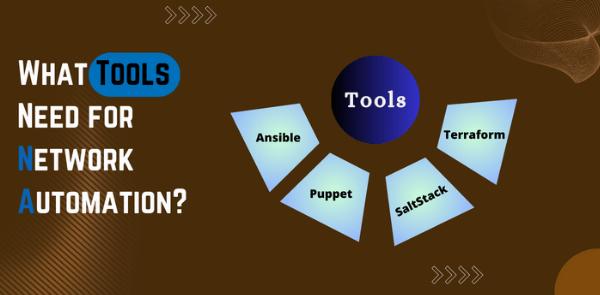The Power of Network Automation Tools

Automation involves executing tasks or processes with little human involvement, reducing reliance on individuals and standardizing procedures to enhance efficiency and reduce human errors.
Network automation tools specifically employs software and tools to automatically handle configurations, provisioning, management, and testing of network devices. Its importance lies in network orchestration, software-defined networking, and network virtualization, facilitating smoother operations.
What are Network Automation Tools?
Network automation tools are software solutions designed to automate the management, configuration, provisioning, and monitoring of network devices and infrastructure.
These tools leverage programmability, scripting, and orchestration to perform tasks that were traditionally executed manually, enabling network administrators to focus on higher-value initiatives.
Need for Network Automation
The exponential growth of devices, the increasing demand for bandwidth, and the emergence of new technologies like cloud computing and IoT have made manual network management obsolete.
Human errors, time-consuming configurations, and the inability to adapt swiftly to changes have highlighted the necessity for automation in network management.
Advantages of Network Automation Tools
Enhanced Efficiency: Automation reduces manual intervention, enabling swift and accurate configurations and updates across the network. Tasks that once took hours or days can now be accomplished in minutes.
Improved Reliability: Automated processes minimize human errors, resulting in a more stable and reliable network environment. Consistency in configurations leads to fewer vulnerabilities and better performance.
Download Free Sample Report
Scalability: Network automation facilitates scalability by easily handling the increasing complexity and size of modern networks. It allows for seamless expansion without a proportional increase in administrative workload.
Faster Troubleshooting: Automation tools provide real-time monitoring and alerting, enabling quick identification and resolution of network issues. Predictive analysis can even anticipate and mitigate potential problems before they impact the network.
Cost Savings: By reducing manual labor, network automation tools contribute to cost savings in terms of time, resources, and operational expenses.
Talk to Analyst Now
How to Choose the Right Networking Automation Tool?
Selecting the right networking automation tool involves considering several key factors to align with your specific needs and goals:
Compatibility and Integration: Ensure the tool aligns with your existing network infrastructure, devices, and protocols. Compatibility with APIs, platforms, and technologies you use is crucial for seamless integration.
Scalability: Consider the tool's ability to scale alongside your network's growth. It should accommodate an increasing number of devices and configurations without compromising performance.
Ease of Use and Learning Curve: A user-friendly interface and clear documentation are essential for efficient adoption. Assess the tool's learning curve and training requirements for your team.
Functionality and Features: Determine if the tool offers the functionalities you require, such as configuration management, automated testing, provisioning, monitoring, and troubleshooting. Prioritize features that align with your specific networking needs.
Reliability and Stability: Look for a tool with a proven track record of stability and reliability. Reviews, testimonials, and case studies can provide insights into its performance in real-world scenarios.
Security: Network automation tools should prioritize security features to safeguard sensitive data and configurations. Ensure the tool complies with security standards and provides robust authentication and encryption mechanisms.
Community Support and Updates: A vibrant user community often indicates active development, timely updates, and extensive support resources like forums, user groups, and tutorials.
Cost and ROI: Consider the tool's pricing model, including upfront costs, ongoing maintenance, and potential savings through increased efficiency, and reduced operational overhead.
Vendor Support and Roadmap: Evaluate the vendor's reputation, responsiveness to support queries, and their product roadmap to ensure continued development and alignment with your future needs.
By considering these aspects and conducting thorough research or Market intelligence reports act as a crucial compass in the journey of selecting the ideal networking automation tool.
These reports distill vast amounts of industry data, providing a comprehensive overview of available tools, their functionalities, and how they align with market trends. By analyzing Quadrant Knowledge Solutions’ Market Share: Network Automation Tools, 2022, Worldwide reports, organizations gain a nuanced understanding of the strengths and weaknesses of various tools in relation to their specific networking needs.
These insights facilitate informed decision-making, guiding recommendations based on the report's evaluations of vendor reliability, feature comparisons, future projections, and real-world use cases. Essentially, market intelligence’ Market Forecast: Network Automation Tools, 2022-2027, Worldwide reports serve as a strategic roadmap, steering organizations towards the most fitting networking automation tool that aligns with their unique requirements and overarching goals.
Popular Network Automation Tools
Several tools cater to different aspects of network automation:
Ansible
Ansible stands as an open-source tool that excels in configuration management and automation. Widely employed for automating software deployment, configuration management, and IT orchestration tasks.
Puppet
Puppet, another open-source automation tool, operates with a centralized server, specializing in network and storage management. It's well-suited for handling intricate infrastructure and automating deployment functions.
Chef
Renowned for its robustness, Chef serves as an automation powerhouse, streamlining infrastructure management tasks. It efficiently automates server configuration, application deployment, and infrastructure monitoring activities.
SaltStack
SaltStack, an open-source tool, showcases prowess in automating software deployment, infrastructure management, and cloud orchestration. Known for its scalability, it efficiently manages thousands of servers concurrently.
Terraform
Terraform, an open-source infrastructure automation tool, excels in creating, managing, and updating infrastructure resources. Its forte lies in automating cloud infrastructure deployments across platforms like AWS, Azure, and Google Cloud.
Napalm
Napalm emerges as a Python-based network automation library, facilitating automated device configuration and network verification tasks. It provides a unified API, ensuring consistency across network devices from various vendors.
Conclusion
In the world of network automation, the right tools are the linchpin for streamlining operations and ensuring reliability. Utilizing market insights helps make informed choices, aligning specific needs with the perfect tool.
From Ansible to Terraform, these tools empower organizations to revolutionize operations, streamline configurations, and scale networks for a future defined by efficiency and seamless connectivity.
Note: IndiBlogHub features both user-submitted and editorial content. We do not verify third-party contributions. Read our Disclaimer and Privacy Policyfor details.







